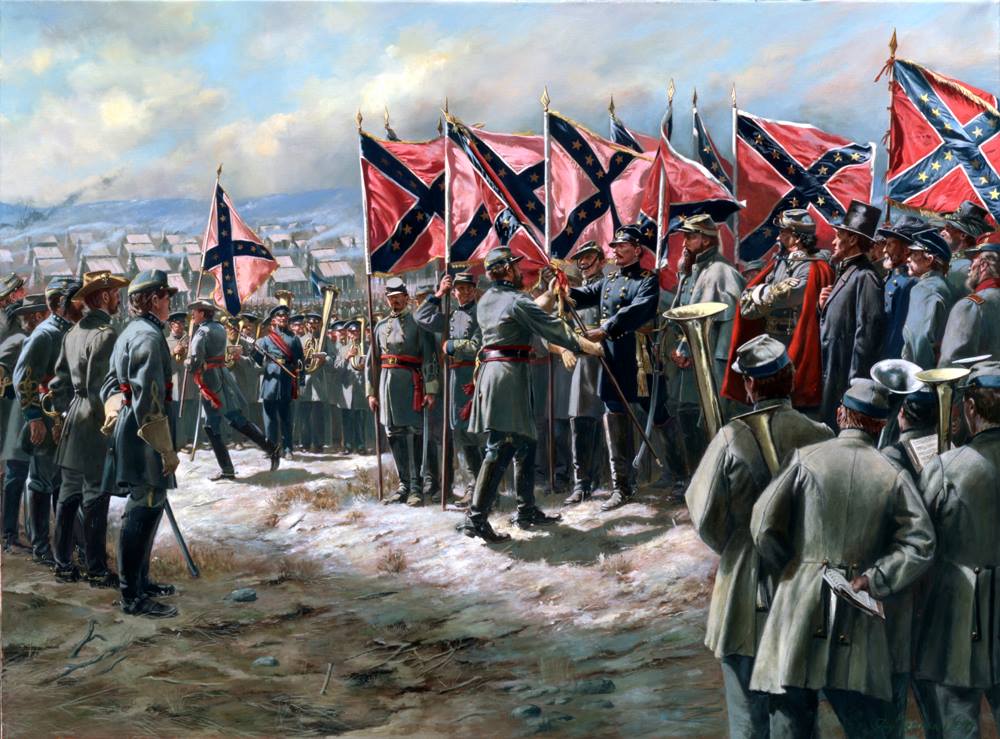
General Beauregard and the Battle Flag.
The "Confederate Battle Flag" is based on
the ancient "Cross Of Saint Andrew". A few confused people are trying to
rewrite history by saying that someone in the 1860s "designed" that flag. How
ludicrous! It is centuries old! When we look at the origin of our
Confederate Battle Flag, aka the Battle Flag of the Army of North Virginia, we
see clearly that Gen. P G T Beauregard did more for the appearance of the
"Battle Flag" than anyone else. Porcher Miles was NOT the "designer" of the St.
Andrews Cross battle flag-aka ANV Battle Flag, aka "Confederate Battle Flag";
that is a false narrative, aka an "urban legend".
Miles chaired the committee that approved the Battle Flag, and his total
contribution was to change ONE color. Beauregard was the first to suggest having
a new Battle Flag and arranged the final appearance of the flag.
It started with the Battle of First Manassas, in which the flags of the
various units were hard to discern in the smoke of battle. In early September
1861, Beauregard wrote to Gen. Joe Johnston:
"We should have two flags - - a peace or parade flag, and a war flag to
be used only on the field of battle - - but congress having adjourned no action
will be taken on the matter - - How would it do for us to address the War Dept.
on the subject for a supply of Regimental or badge flags made of red with two
blue bars crossing each other diagonally on which shall be introduced the stars,
the edge of the flag to be trimmed all around with white, yellow or gold fringe?
We would then on the field of battle know our friends from our Enemies."
(source - - "The Confederate Battle Flag" by John M. Coski)
General Beauregard gives the background
and circumstances on how it came about in a book entitled: The Military
Operations of General Beauregard in the War Between the States Vol I, 1884.
Quote - - " At the battle of Manassas, on the 2lst of July, 1861, I found it
difficult to distinguish our then Confederate flag from the United States flag,
especially when General Early made the flank movement which decided the fate of
the day, and I determined at that time to have adopted a "battle-flag"; which
would be entirely different from any State or Federal flags."
"I submitted my views on the subject to General Joseph E. Johnston,
commanding, who approved of them, and to the Confederate States War Department,
who made at first some objections to them, but finally consented. I then
designed a diagonal red cross with white stars on a blue field, but on
consultation with General Johnston and Colonel ...Miles, Chairman of the House
Military Committee, the latter gentleman suggested a red ground, with a blue
cross, and the former a square flag, instead of the slightly oblong one devised
by me; these suggestions were adopted, after colored drawings of the two flags
had been made and discussed, as well as a nearly corresponding one from Colonel
J. B. Walton of the Louisiana Washington Artillery."
This is from page 485 of said book. General Beauregard's statements are
corroborated by Gustavus Smith-who was at First Manassas, and Thomas Jordan who
agreed with General Beauregard and said, "I will state now that I distinctly
recollect that the origin of our battle-flag was due to the trouble which arose,
as you say, at the battle of Manassas, in consequence of the similarity between
the Confederate and Federal flags, on that occasion. I remember that you at once
set to work to find a guard against a similar accident..." This quote is on page
486 of the same book.
ALSO we offer: Confederate Veteran Magazine 1907, page 70:
"...between the hours of three and four in the afternoon of July 21, 1861, when
the Southern troops had been beaten back at various points and the fate of the
Confederacy appeared to be trembling in the balance, General Beauregard, in
looking across the Warrenton Turnpike, which passed through the valley between
the positions of the Confederates and the elevations beyond occupied by the
Federal forces, noticed a body of troops moving toward his left. He was in great
concern to know whether they were Union or Confederate, but could not decide
because of the similarity of the colors carried.
During this terrible anxiety General Beauregard determined that the Confederate
soldiers should have a flag distinct in design..."
This article does mention Miles being consulted, but attributes the design to
General Beauregard.
ALSO: A book entitled: Flags and Seal of the Confederacy by Keith Olendorf and
published in 1983 states:"This flag was conceived after the Battle of First
Manassas...July 21, 1861. It was during this battle , through the experiences of
General PGT Beauregard, that the battle flag was born. Soon after the battle,
General Beauregard decided that the Confederate soldiers should carry a distinct
flag into battle so as not to cause confusion on the battlefield again." That is
from page 4.
ALSO: In Confederate Veteran March and April of 1987 an article by Deveraux D
Cannon entitled 'The Confederate Flag' appears on page 5. We quote again:
"...similarity soon provoked a problem, for on a field of Manassas, in the smoke
and dust of battle, troops and commanders often found it difficult to
distinguish the flags of warring countries. As a direct result of this, General
PGT Beauregard commended a design for a battle flag to be used by the army in
the field..."
The idea was Beauregard's. The arrangement was Beauregard's. Miles
recommended changing one color. Beauregard submitted an oblong (rectangular) flag and Miles
recommended changing it to
the square ANV design. However, the oblong (rectangular) design was the AOT flag. So while
Miles was involved as Chairman of the Committee, he did NOT come up with the
idea for the flag, nor the overall appearance. This false re-direction of history is similar to
an attempt a few years ago to start a rumor that one of the CSA National flags
was designed by someone who was a racist. That was nothing but a
despicable mudslinging falsehood, and it was quickly disproven, debunked,
ridiculed and completely flushed, just like this failed attempt to rewrite the
origin of our honored Battle Flag.
The Battle Flag, aka Confederate Battle Flag, is the brainchild
of General P.G.T. Beauregard. It is the soldier's flag, designed FOR soldiers BY
soldiers.
When searching for truth one MUST go to original sources. Outsiders, and
'modern Confederate historians', not of Confederate blood and no matter how
well-meaning, have done some damage with trying to re-attribute the design to
Miles. They have dishonored General Beauregard and the Southern soldiers who
were on the battlefield and in so doing have dishonored themselves.
We strongly urge a reading of The Military Operations of General
Beauregard by Alfred Roman volume I published in 1884. This book goes in depth
with letters between all involved with the origin of the "CBF".
General Beauregard's own words are corroborated by those who were there, and
other first person accounts. In letters between Miles and Beauregard, Miles
never took credit for that flag.
To be fair, we can credit Porcher Miles with helping to create the First
National flag, aka the Stars And Bars. He had suggested that the Saint Andrews
Cross be incorporated into that flag, but the rest of the Congressional
committee voted against it.
And now you know the truth and facts about the true origin of the Battle Flag of
the Army of Northern Virginia.. Those who would attempt to rewrite history
are the South's enemies.
Also read about the origin of the "Battle Flag" and other CSA flags here:
http://www.sonofthesouth.net/leefoundation/Confederate_Flag.htm
More agreement about Beauregard, Johnston and the Battle
Flag:
http://www.shenandoahatwar.org/news-and-press/policy-statement-confederate-battle-flag/
A great defense of the flag:
https://sonsofthesouth.blogspot.com/2008/03/columnist-has-no-right-to-interpret.html
..........................................................
On November 28, 1861, in ceremonies at Centreville and Manassas, Virginia, attended by Generals Joseph Johnston and G. T. Beauregard, Confederate soldiers of the Army of the Potomac (later the Army of Northern Virginia) received their new battle flags. The new flags were mostly pink and rose silk (red silk being hard to come by at the time).
General Beauregard gave a speech encouraging soldiers to treat their new battle flag with honor and stressed that it must never be surrendered. Many soldiers wrote home about the ceremony and the impression the flag had made upon them, the "fighting colors" boosting morale after the confusion at the Battle of First Manassas. From that point on, the battle flag only grew in its identification with the Confederacy and with the South in general.

Artwork: Don Troiani
..........................................................
A variation of Beauregard's "Battle Flag" was introduced in March 1862 - - the "Cassidy" flag.
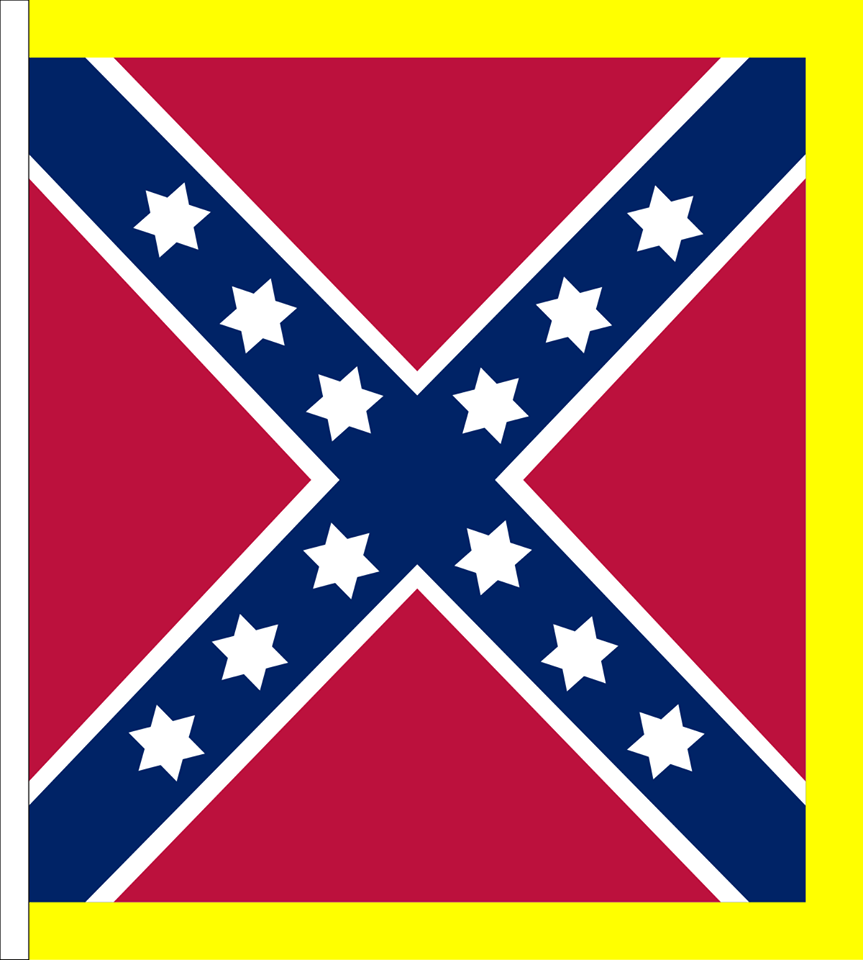
Cassidy Pattern Flags issued to Bragg's Troops
Fifty flags were furnished on 25 February 1862 and sent to
Beauregard through one of the regimental quartermasters
of Bragg’s congregating forces. These flags arrived at Jackson, Tennessee on 3
March 1862.
Although based on the eastern army’s general design, the new Cassidy made battle
flags differed from their Virginia counterparts in several respects. Their
fields were made from a red wool-cotton blend, quartered diagonally by a dark
blue St. Andrew’s cross of similar material, the cross edged on its sides with
1″ wide white cotton. Each of the four arms of the cross bore three white silk
stars, totaling twelve, and hence suggesting that either Beauregard’s personal
headquarters battle flag or the battle flag that he had brought from Virginia
for the 5th Company of Washington Artillery of New Orleans had served as the
pattern for Cassidy. Moreover, rather than the Americanized 5-pointed stars, the
flags that Cassidy produced would bear heraldically correct 6-pointed stars.
Finally, a yellow serge or bunting border edged the three exterior sides of the
flags.
The first two sets of Cassidy-made battle flags were intended to be square, but since the borders were added to only three sides and the white cotton heading on the fourth side was considerably less in width than the borders (usually half as wide), the overall effect produced flags that were usually slightly rectangular by 3″ to 5″, with the hoist usually being greater.
Cassidy’s invoice of 29 March 1862 indicated that the 50 flags he delivered on 25 February were in three price ranges — 30 at $6.75 each, 12 at $5.25 each, and 8 at $4.75 each. These prices reflected the three sizes of flags ordered. The 30 infantry flags measured 48″ to 51″ on their hoist by 42″ to 45″ on their fly. The 12 artillery size flags had been intended to be 42″ square, but for the same reason as the infantry flags varied as much as 2″ on the fly from that ideal. The 8 cavalry size flags measured 36″ on the hoist by 34″ on the fly.
As of 9 March 1862, Bragg’s “2nd Grand Division” of the Army of the Mississippi consisted of 20 infantry battalions or regiments, 6 artillery batteries, but only two cavalry units. However, by the time of the battle of Shiloh, Bragg’s (now) “2nd Corps” had expanded to include 10 more infantry units, 2 new artillery batteries, and two new cavalry units. Hence, though the artillery and cavalry flags were still in surplus of the corps’ actual needs, all 30 of the infantry flags were accounted for.
Deo Vindice!
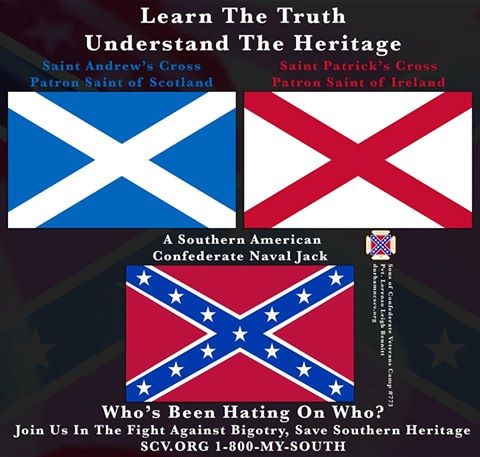
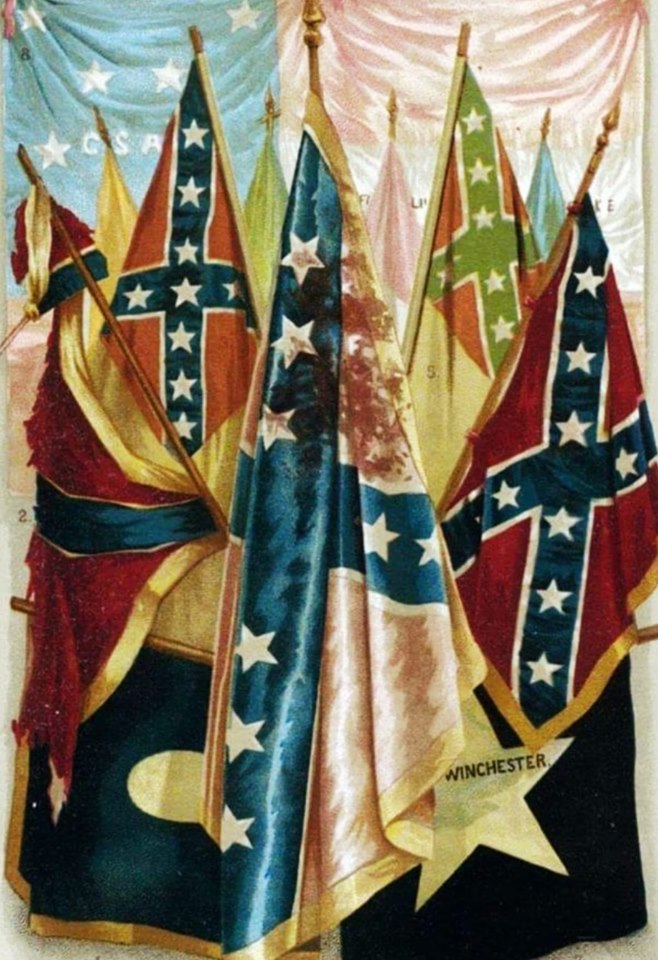
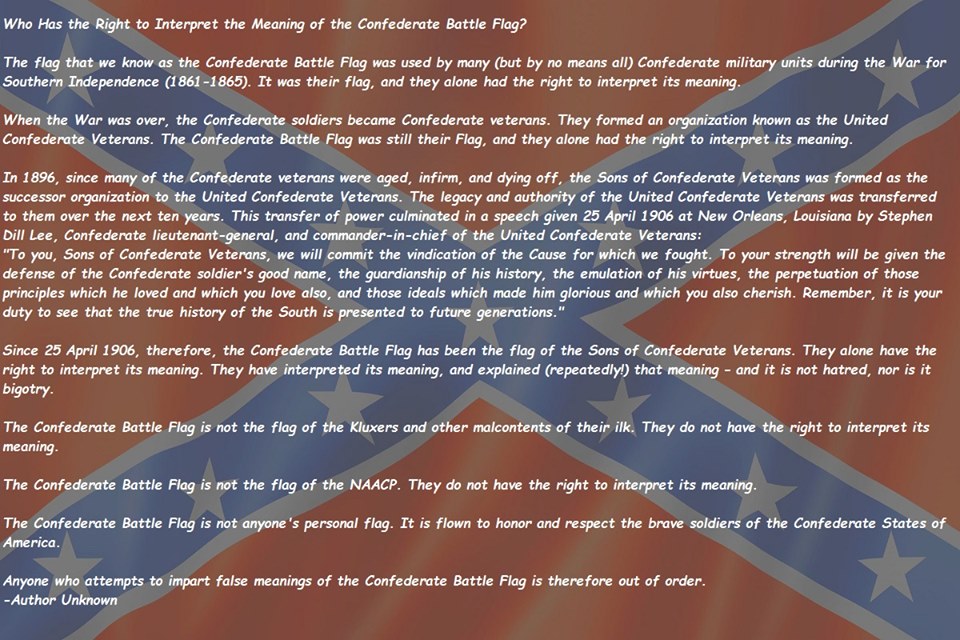
Not "unknown" - - CPM is alive and well.
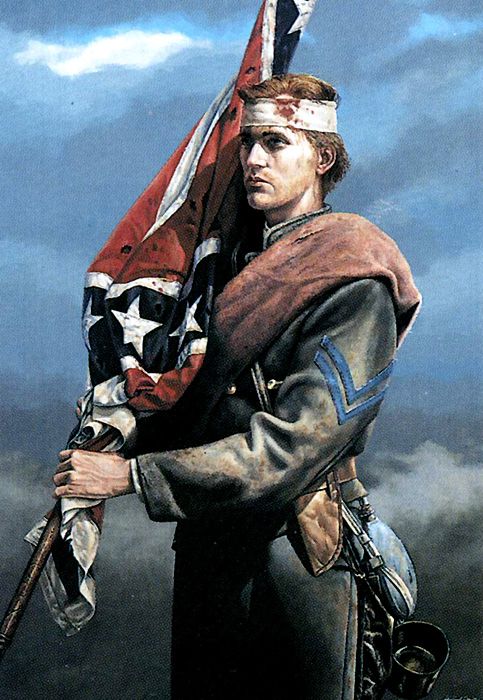


I am the Battle Flag of the Confederate States of America.
I am a proud flag.
I have led great armies to great victories.
From tall masts I have saluted,
And been saluted by,
The ablest generals in history.
I am a potent symbol.
I have the power to stir the blood
Of those who carried me in battle
Though that blood be continents away
And generations removed from those battles.
I am an honorable flag.
Do not use me for ignoble purposes.
I am a symbol of pride, not arrogance.
I represent love of homeland, not hatred toward anyone.
But no matter who carries me
Or for what purposes, I cannot be dishonored.
I secured my honor in a hundred battles
Where good men dying passed me to good men still struggling;
Where we prevailed against almost impossible odds;
Where we were beaten by overwhelming numbers;
Where I was as bloody, torn, tired, and soiled
As the men who carried me.
I am a worthy flag.
I have stood watch over the graves of patriots.
I have comforted widows in their loneliness.
As a blood-stained rag I have been passed as a rich legacy
To the heirs of those who had lost all for my sake.
I am the Battle Flag of the Confederate States of America.
Do not forsake me.
